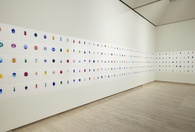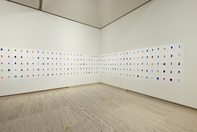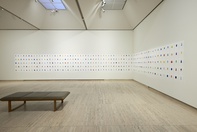David Sequeira
Wurundjeri/Boon Wurrung Country, Melbourne
2023
Displayed 2023 at Art Gallery of New South Wales

David Sequeira
Born 1966, New Delhi.
Lives and works Wurundjeri/Boon Wurrung Country, Melbourne.
Grounded in the languages of colour and geometry, David Sequeira’s work explores ideas about endlessness and contemplation. The ‘small acts’ which lie at the heart of his work – painting minute daubs of gouache on paper and pursuing infinity through circle and line – allude to grand ideas about interconnectedness, wonder, and speculation. Sequeira has exhibited his work extensively throughout Australia, and he is included in the TarraWarra Biennial 2023: ua usiusi faʻavaʻasavili. Sequeira’s artist-in-residency projects include works made at the Australia Council for the Arts Cité internationale des arts residency, the Asialink residency in Pakistan, the University of Texas, Curtin University, and the JamFactory Glass Studio.
Photograph: Christian Capurro
Artist text
by Scott Elliot
During the long Melbourne lockdowns of the COVID-19 pandemic, David Sequeira could be found in his home studio with a pencil, a compass, tubes of gouache, and a bundle of blank sheet music. In the centre of each page, he would draw a small geometric pattern of intersecting circles and apply jewel-like concentrations of colour. These modest paintings, what the artist calls ‘songs,’ became sources of illumination and resonance in a world that had turned grey and silent.
Each song is a compact fusion of simple elements. Where circles intersect, their individual colours blend to create distinct chromatic transitions and new shapes within shapes. The effect is one of light passing through overlapping lozenges of translucent pigment, giving a sense of looking into something crystalline and bottomless. The circular compositions contrast with the musical staff, whose horizontal black lines spread insistently across the page. Sequeira’s paintings bloom over these lines, from their centres out, like still points on an infinite current of time.
For The National 4 he presents over 300 songs in a grid along the gallery walls. The 12-metre–long display does not represent a culmination of the project – like the fugue structure in music, where a melodic theme is continually repeated but with minor deviations every time, the Song Cycle (2020–21) has no logical end. Each painting is a rephrasing of what he calls ‘the same work.' (1) Inside the parameters of coloured gouache and the geometry of the circle, Sequeira finds endless room for variation.
The fugue has some resemblance to an Indian musical form called the raga. Although the performer of a raga follows a set framework, they can improvise to enhance the given theme, which might be the mood of a season or time of day. No raga can ever sound the same. This emergence of the singular and distinctive out of the structured and predictable is a source of fascination for Sequeira, and is what propels the Song Cycle forward. Each song is an exercise that draws him closer to the bare logic of creation, to the bliss of witnessing difference unfold out of sameness.
The word raga comes from the Sanskrit word ‘to dye’ and the raga is understood to ‘colour the mind’ of the listener with emotion. This is close to Sequeira’s own understanding of the relationship between music and colour, which is about metaphorical correspondence, rather than synaesthetic experience (perceiving sound as colour and vice versa). He describes colour as a ‘verb’ that ‘has a kind of energetic force or presence.’ For Sequeira, both colour and music have a resonant power that can seep into our consciousness.
He extends this idea to language in the Song Cycle by including titles in pencil at the bottom of the works. ‘Song for the Absolute,’ ‘Song for Expansion,’ or ‘Song for Immunity’ come from words that he encounters and collects – concepts that take up space in the mind and colour the passing of a day. Sequeira knows we can’t see these concepts, just as we can’t hear his songs: this gentle confounding of expectations is an invitation to contemplate the abstract nature of inner experience, to behold the chorus of intangible resonances that makes up our realities.
(1) Interview with the artist 8 November 2022
Auslan - David Sequeira
3min
About the work of David Sequeira in The National 4.








